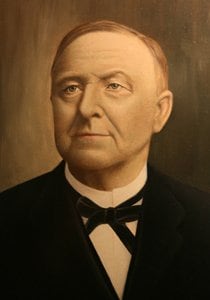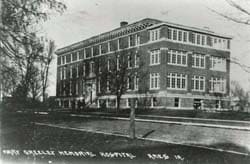History
Mary Greeley Medical Center, which opened in 1916, was a gift to Ames from Captain Wallace Greeley, an officer in the Union Army during the Civil War who went on to become a prominent banker, businessman and mayor of Ames during the 19th and early 20th centuries. His beloved wife, Mary, died in 1914, leading her grieving husband to build the hospital and give it to the community.
At the hospital’s dedication on September 24, 1916, which was attended by more than 2,000 people, Captain Greeley eulogized his wife by saying, "It affords me great pleasure, more than words can express, that I contribute something towards the welfare of not only those now in need, but also for those who will be here long after we have passed away."
A Most Magnificent Gift
Wallace and Mary Greeley had a significant and lasting impact on central Iowa.
Mary Greeley Medical Center, which opened in 1916, was a gift to Ames from Captain Wallace Greeley, an officer during the Civil War who went on to become a prominent banker, businessman and mayor of Ames during the 19th and early 20th centuries. His beloved wife, Mary, died in 1914, leading her grieving husband to build the hospital and give it to the community.
Capt. Greeley

Wallace Greeley
Wallace Greeley was born on March 15, 1840. He grew up in western New York state and spent his summers working on a farm.
He served in the Union army during the Civil War, quickly ascending to the rank of major. He preferred to be referred to a Captain, however, a title that stayed with him the rest of his life. Following the war, the 26-year old headed west. (This was just about the same time his distant cousin, newspaper editor Horace Greeley, used the famous phrase, “Go West, young man,” in an editorial in the New York Tribune.)
Wallace’s journey brought him to Ames, which was a village of 100 people at the time. He used $3,200 in Union Army pay he had saved to purchase 200 acres of farmland in Section 16 of Washington Township. Today, the Gateway Center, the Green Hills Retirement complex, a number of condominiums and part of the Highway 30 interchange with University Boulevard are on the land.
He returned to New York state to reunite with Mary Victoria Young, whom he had met while both were at a teacher’s institute in New York. (Mary was born in Villanova, N.Y., on Feb. 27, 1847.) They married in 1866. Wallace returned to Iowa with Mary in 1868. Those who knew him at the time, could see that he was primed for success.
“Captain Greeley…was relatively young when he took up his work at Ames, but he had an experience on the farm and the battlefield which proved that he could align himself to duty in both peace and war, and that he possessed the qualities that make for the leadership of men,” read a tribute published in the Ames Weekly Tribune in the weeks after Wallace’s death in 1917.
Mary Greeley

Mary Greeley
In those early days of their marriage, Wallace focused on farming, but had an eye out for opportunities that would bring bigger things. As Ames began to grow, Wallace and Mary moved off the farm and into a home near the city center. In 1882, the Greeleys built their home at 502 Douglas Ave.
Because Mary was only 4 feet 10 inches tall, all the doorknobs were two and one-half feet off the ground, compared to the three-foot standard. The former Greeley residence is now a funeral home. Among the wealthiest couples in Ames, the Greeleys entertained and had public social gatherings in their home. Though a shy and private person, Mary gave an annual soiree, which was a prominent Ames event.
Mary had a deep appreciation for the arts. She was a self-taught painter, and many of her pieces adorned the walls in her home. She had the first grand piano in Ames. It was through this love of the arts that the Greeleys donated the original site for the Ames Public Library.
Soon, the Greeleys were among the most prominent citizens in town.
Community Leaders
Wallace’s penchant for leadership served him well in business. He established the Union National Bank and later added the adjunct of the Union Savings Bank. Wallace served the community as mayor for three terms and as a state representative for three terms.
Wallace was by all accounts a serious but generous man who was known for helping people. He avoided any credit or accolades for it. In a story after his death, a local paper reported: “It has always been considered in this community, where he has resided for so many years, that his life was an open book. To a certain extent it was. But there shall never be known the kindly service he has done to so many people. Mr. Greeley was a man of retirement and the assistance he has given in the past forty years to those whom he considered deserving must come from their lips.”
One of the few remaining images of Wallace shows him standing near the bank, his face partially shadowed by his hat. According to one account, the photographer asked Wallace to remove his hat. His reply: “What for?” The hat remained.
Wallace’s success in business was matched by Mary’s generosity in serving the community. Mary was petite, just 4’ 10”. Though a shy woman, she and her husband entertained frequently at their home. She was also reported to be a talented painter, though none of her works survive.
Mary was a charter member of the local P.E.O. chapter and, along with Wallace, granted the land on which Ames’ Carnegie library was built. Mary died of pernicious anemia in 1914, her husband and sister by her side.
In a letter of appreciation memorializing Mary, Mrs. Julia Stanton and Mrs. Margaret Sowers, provided insight into the kind of woman she was. “…she has been a cheerful worker, a modest but wise adviser, giving her best judgement…We who have served with her, know how helpful has been her unselfishness, her untiring faithfulness, and her optimistic vision of the work and its possibilities.”
A Gift
A February 1917 article in the Nevada (Iowa) Representative reported that after Mary’s death, “it was very plain to (Wallace’s) friends that the world had not to him been quite the same world as it was before.” Though in the wake of Mary’s death, the Greeley legacy in Ames and beyond was truly sealed.
In a grand gesture of his love for his wife, Wallace gifted the construction of Mary Greeley Memorial Hospital to the City of Ames. At the time, there were 10 medical physicians and two osteopathic physicians in Ames. Greeley consulted with these physicians about where to locate the new hospital and what to include in the building. He also brought in a medical specialist from Chicago who was nationally known as a consultant in design and construction of hospitals.
Greeley’s generosity filled a pressing need for a full service hospital in the growing Ames community. Prior to this, Iowa Agricultural College had a small hospital on campus, and there was a sanitarium, operated by the Seventh Day Adventists, in the nearby community of Nevada. “He had mourned as men are not often observed to mourn the death of his wife, he had dedicated to her memory a splendid hospital for the city where they had lived and wrought,” reported one local newspaper.
Capt. Greeley had very high hopes for the hospital. A December 1915 newspaper story quoted him as saying: “I cannot tell exactly what it will cost when completed. From present indications the figures will range between $75,000 and $80,000. Whatever is necessary will be expended and everything provided to make the institution up to date in very detail.”
Mary Greeley Hospital Opens

Mary Greeley
Memorial Hospital, 1916
Another news account at the time captured the excitement about the still-under-construction hospital. It described the hospital as “a most magnificent gift, and an institution which has been greatly needed by Ames. It would have been impossible for Captain Greeley to have thought of a more timely and acceptable offering … Captain Greeley is not ostentatious in his charity but many acts of kindness and assistance at needful times are known to his close friends.”
The hospital was officially dedicated on Sept. 23, 1916. On Dec. 22, 1916, several weeks after the dedication, the hospital officially opened. It had 30 patient rooms and a solarium on the south side of each floor.
An open house the day the opening before attracted hundreds. In describing the event, a local newspaper offered this memorable run-on sentence: “To all those besieged with the age-old belief that a hospital is a great cold machine, instead of the bright, good-natured, humanely comforting oasis it is with a mission to radiate health and happiness, lost all those foolish notions yesterday, when passing through the enchanting rooms of white enamel and handsome furnishings.”
The first patient admitted to Mary Greeley Memorial Hospital was J.H. Schantz, an Iowa State veterinary medicine student from Villisca. He was a surgical patient. During the first two weeks of operation, the hospital had 27 patients. “The first few patients were housed on the first floor but it has now become necessary to use the third floor and hospital authorities do not anticipate that it will be long before the second floor will be put into service,” reported the Ames Evening News.
Today, Mary Greeley is a 220-bed hospital with more than 1,300 employees and a medical staff of more than 200 providers covering 35 specialties and sub-specialties. The hospital serves the residents of a 14-county region in central Iowa, admitting more than 8,000 people a year.
This growth has been made possible by generations of caregivers who have served Mary Greeley Medical Center, and, in doing so, honored the words that Capt. Greeley himself said to the crowd of 2,000 people at the Sept. 23, 1916 dedication of the hospital that bears his wife’s name: “My purpose in the erection of this building is not for any credit that may accrue to me individually but to the memory of one I can never forget. In tendering you this gift I trust that it will be received in the same spirit in which Mrs. Greeley would have wished were she here and I hope that the loyal people of Ames will tenderly guard its keeping and make it a home for many needy and afflicted persons whose care will be entrusted to them during the future life of this institution.”
Four months after the opening of Mary Greeley Memorial Hospital, Captain Greeley passed away in his home on February 15, 1917, of a stroke. He is entombed with his wife and her parents in a mausoleum in the Ames Municipal Cemetery.